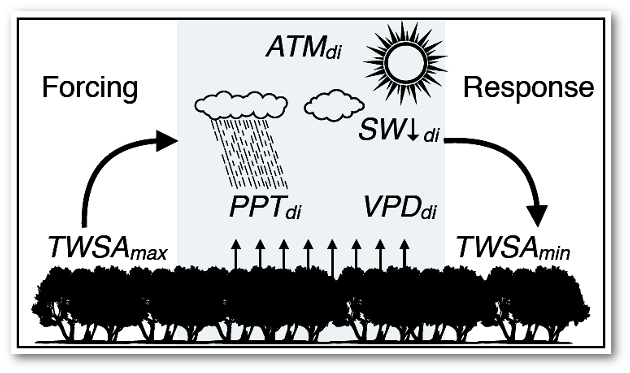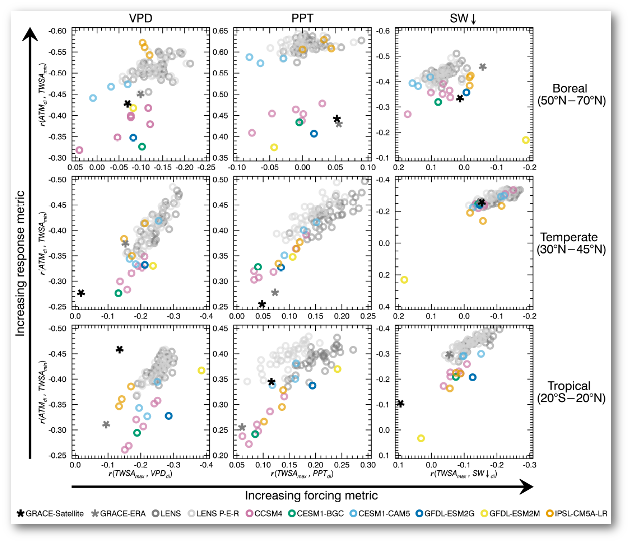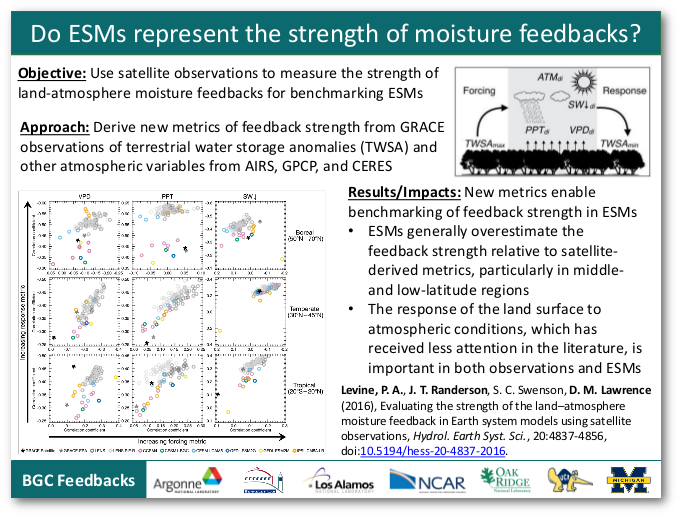Research Highlights
Spaceborne observations enable benchmarking of land–atmosphere moisture feedback strength in ESMs
December 9, 2016
Analysis of remotely sensed data suggests coupled ESMs overestimate feedback strength
The Science
Researchers from the University of California Irvine and the National Center for Atmospheric Research developed a novel method for measuring the strength of the land–atmosphere moisture feedback using global satellite observations. These feedbacks are initiated when the land surface moisture state influences atmospheric conditions by limiting the partitioning of incoming energy between the latent and sensible heat fluxes. These atmospheric conditions then go on to influence the land surface in the full feedback loop. It is important for models to correctly represent the strength of this feedback loop in order to correctly predict climate extremes and project long-term climate change.
The Impact
The current metrics, derived using a suite of remote sensing platforms of both terrestrial water storage and atmospheric conditions, enable coupled models to be benchmarked relative to observations.
Summary
Results indicate that ESMs may be overestimating the strength of the feedback loop relative to observationally derived metrics. While these results are limited by the relatively short time series of satellite data, the metrics described in this study will become increasingly useful as the length of the satellite record increases. However, even with the current limitations, these metrics may be used to evaluate further development of ESMs, particularly representations of land surface processes and planetary boundary layer development.
Objective
Use satellite observations to measure the strength of land–atmosphere moisture feedbacks for benchmarking ESMs
Approach
Derive new metrics of feedback strength from GRACE observations of terrestrial water storage anomalies (TWSA) and other atmospheric variables from AIRS, GPCP, and CERES
 |
Figure 1: Representation of the interactions between TWS and atmospheric component, demonstrating the forcing limb of the feedback loop, in which TWSA max forces subsequent atmospheric conditions, as well as the response limb, in which TWSA min responds to the atmospheric state during the drawdown interval. |
 |
Figure 2: Scatter plots of forcing and response metrics for LENS and CMIP5 models with observations, averaged across land regions within different latitude bands. For LENS, we show metrics calculated using the explicit TWS output (darker gray) and TWSA estimates from the accumulated residuals of the surface water balance (lighter gray). For CMIP5 models, we calculated metrics using TWSA estimates from the accumulated residuals of the surface water balance. |
Results/Impacts
New metrics enable benchmarking of feedback strength in ESMs
- ESMs generally overestimate the feedback strength relative to satellite-derived metrics, particularly in middle- and low-latitude regions
- The response of the land surface to atmospheric conditions, which has received less attention in the literature, is important in both observations and ESMs
Levine, Paul A., James T. Randerson, Sean C. Swenson, and David M. Lawrence. December 9, 2016. “Evaluating the Strength of the Land–Atmosphere Moisture Feedback in Earth System Models Using Satellite Observation.” Hydrol. Earth Syst. Sci., 20(12):4837–4856. doi:10.5194/hess-20-4837-2016.
